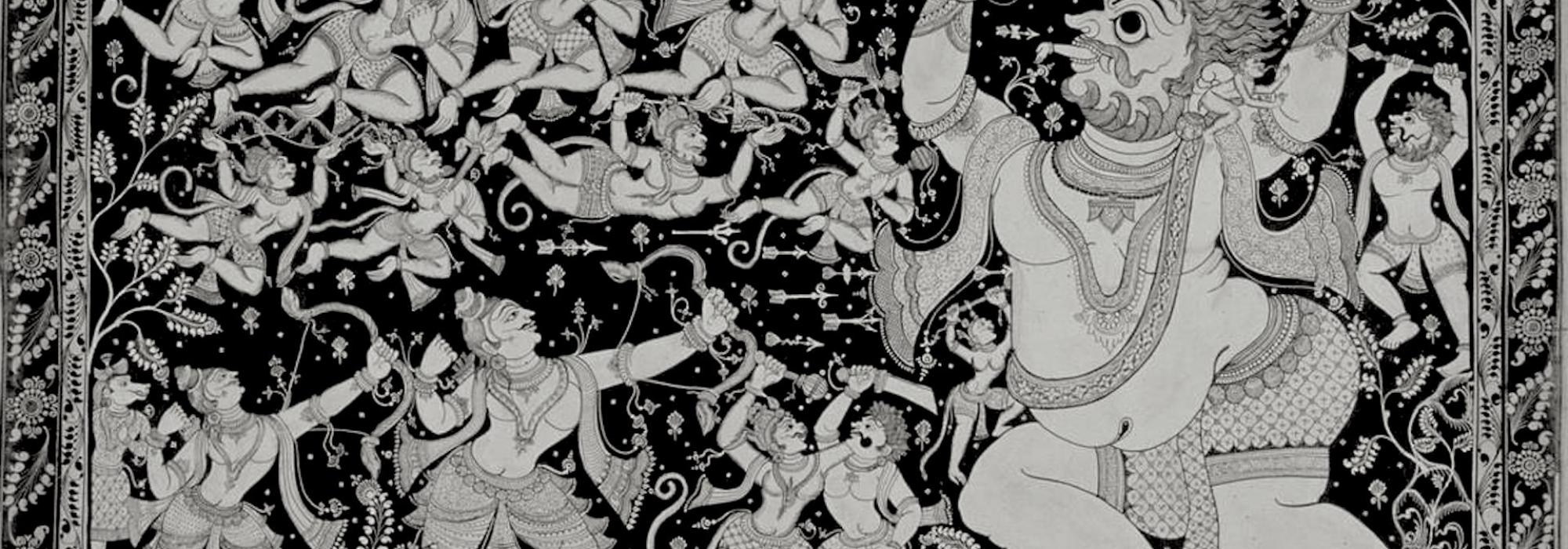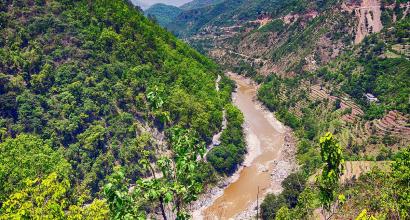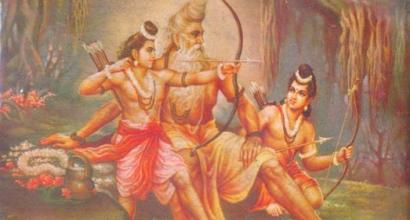Let’s consider another example. Sri Rama is in the forest. Dasharatha who is stricken with sorrow at the separation from his son, is lamenting with his queens:
manye khalu mayā pūrvaṃ
vivatsā bahavaḥ kṛtāḥ |
prāṇino hiṃsitā vāpi
tasmād idam upasthitam || (Ayodhyakanda: 39:4)
“This is how I feel. Sometime in the past, I must have caused the separation of numerous children from their parents; or I must have indulged in the torture of animals. As the fruit of those sins, the present suffering has come upon me.”
yad ācarati kalyāṇi
śubhaṃ vā yadivāśubham |
tad eva labhate bhadre
kartā karmajam ātmanaḥ || (Ayodhyakanda 63:6)
“O Kausalya, whatever a person performs—be it auspicious deeds or sins, he gets back the same in return.”
As an illustration to this principle, Dasharatha recalls a past incident from his life. Sometime in his remote past, when he had set out on a hunting expedition, night fell. In the darkness, he heard some sound. He fell into a delusion and thought that it was the sound of an elephant playing in water and shot an arrow in that direction. However, the arrow struck the son of a Rishi. Thus, Dasharatha discharged an arrow under an illusion based on sound thinking that it was some animal. The Rishi’s son died due to this wound. Something was thought but something else occurred.
Dasharatha was a hasty man, endowed with a rash nature – this is what we learn from this incident. The boon that he gave to Kaikeyi was also done in rashness. Didn’t he say, without any thought, that he would give whatever she asked? Did he put forth any conditions when he gave his word: is the object really mine? If it is indeed mine, then I’m free to that extent but you cannot ask things that don’t fully belong to me. No. He didn’t impose any such conditions. He never had such foresight. Later, when Kaikeyi actually asked for the boon, did he keep the window of opportunity open to deliberate whether what she asked for was just or unjust? Indeed, he did not think of any such situation. The bewitching damsel asked him something; the naïve man said, “whatever it is, it is all yours.” Dasharatha was in a hurry to impress his young wife during wartime; he was equally in a hurry to fill his basket while he was hunting. What is the use of possessing a thousand other virtues? In this great king who flourished due to his courage and magnanimity, the mentality of rashness culminated into a fatal weakness. The actions taken without thinking about consequences became disastrous.
The other ideal personality in Maharshi Valmiki’s world is Bharata. It is not easy to decide whether Bharata’s sacrifice was greater or that of Rama’s. In the world that Valmiki has painted, Sri Rama, Sita Devi, Lakshmana, Bharata and Anjaneya—these five are the warriors of renunciation. Who is the greatest among them? When we stand amidst a dense forest and look upwards, we feel as if the tips of the massive trees are touching the sky. Which among them is the tallest? All of them are definitely taller than us. To a certain extent – till the height that we can reach with our hands – we can measure the height of another object. If a tree or hill or mountain has grown beyond that height, it is not possible for our mere eyes to measure that excess height. Likewise, the majesty of character of great people does not lend itself to the confines of our yardstick. Our place in life is to stand afar and bow down our heads before all these Murtis.
According to an ancient dynastic tradition, the kingdom of Kosala had to automatically pass on to Sri Rama. Had Dasharatha not interfered in this matter, had Manthara not provoked Kaikeyi, had there not been the premise of Dasharatha’s hasty promise, the kingdom of Kosala would have belonged to Rama without anybody’s attempts and without any arguments. In this manner, Rama on his own volition, renounced the kingdom which rightfully belonged to him by the authority of national tradition by bowing down to the principle of upholding the truth.
As for Bharata, the kingdom was offered twice. The first time due to the words of his parents; next, on account of Rama’s own words. In this manner, Bharata gave up that which was offered to him on two occasions. Not just that. When Rama refused the kingdom and insisted that Bharata rule it, did the latter ascend the throne? No. He regarded Rama’s footwear as the icon of Sri Rama’s kingship, respected and worshipped it as if it was the manifest form of Sri Rama himself, and akin to a worker who submits his administration to another Master, submitted the kingly works to Rama’s footwear and ruled the kingdom. This is a phenomenal episode of fidelity to duty.
yadā hi yatkaryamupaiti kiñcit
upāyanaṃ copahrutam mahārhaṃ |
sa pādukābhyāṃ prathamaṃ nivedya
cakāra paścādbharato yathāvat ||
Bharata forsook the opulent luxuries of ruling the kingdom and opted to shoulder the burden of its duties. He is a Tapasvi; a duty-minded Tapasvi. Bharata was that great soul who had harmonized both worldliness and the renunciation of worldly life.
Bharata truly followed these words of the Ishavasya Upanishad:
tena tyaktena bhuñjīthā... |
kurvanneveha karmāṇi |
jjīviṣet śataṃ samāḥ ||
The greatness of Bharata lies in how he showed in practice, the equanimous blend of renunciation and worldly life.
Bharata placed Sri Rama’s footwear on his head, proclaimed its glory and prestige throughout the kingdom and till Sri Rama returned, became a Yati (monk), became emaciated, became a devotee, and became humble. The descriptions of various episodes involving this Bharata wedded to truth and Dharma will shake and melt any person’s heart and distill one’s life itself.
Those who read the Ayodhyakanda especially the 99 – 114 Sargas even once will find themselves reading them repeatedly – this is my conviction. The scenes and conversations are truly beautiful.
The Ayodhyakanda which culminates in a portrait of Sita-Rama’s romantic life is truly auspicious. As Anasuya tells Sita: “Devi, the night is lovely. This is the time when the animals and birds will be asleep. The moonlight is joyous. Bedeck yourself with auspicious decorations and prepare your mind to be with Sri Rama.”
Later, upon seeing Sita once more, she says:
alaṃkuru ca tāvatvaṃ
pratyakṣaṃ mama maithili |
prītiṃ janaya me vatse
divyālaṃkāra śobhitā ||
To be continued
















































